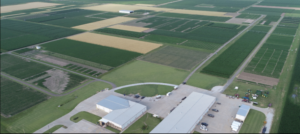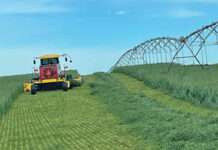As reported in High Plains Journal, corn growers in the High Plains have wrestled with limitations of water and impacts of drought. Irrigators typically have less water available from aquifers, reduced pumping capacity or restrictions in application rates.
Brian Olson, manager of the Bayer’s Gothenburg Water Utilization Learning Center, noted university studies that point to Garden City, Kansas; Imperial, Nebraska; and Burlington, Colorado, that growers traditionally had to have about 26 inches of precipitation to maximize corn production. Those regions on a 30-year average fall short of that total from Mother Nature, which means about 11.5 to 12 inches of supplemental irrigation are needed to reach a field’s yield potential. Growers in those regions have been known to hit 300 bushels per acre.
However, irrigation water is not an unlimited resource as producers in the Ogallala Aquifer know. Western High Plains growers have watched wells in that region produce over 1,000 gallons a minute 40 years ago to less than 300 gallons a minute today. Growers in management districts who have agreed to only pump 55 inches over a 5-year period can be pinched if they have been taking out 14 inches earlier because of a dry year and they may be limited to 8 inches to irrigate for the current season.
Growers should weigh all options if their goal is to maintain profitable corn production in the face of extended droughts, he said. “How do you get the best value out of that 8 inches?”
He likes growers to focus on long-term moisture retention strategies, and Kansas State University’s Research and Extension and other universities back those strategies. Residue cover can decrease soil water evaporation by 3 inches compared with bare soil, he noted, from the K-State study near Garden City from 2004 to 2006. A study by the University of Nebraska-Lincoln West Central Research and Extension Center in North Platte, Nebraska, indicated that high corn and soybean yields were attained with residue covers. In two of those years corn had higher yields of 25 and 17 bushels, per acre and results in water savings of 3 to 3.5 inches, respectively. That period was for 2007 to 2010.
“Strip-till on fields is a great tillage system and no-till is the gold standard for decreasing evaporation,” Olson said.
Height of the residue can also allow greater capture of snow. “You want to trap it right where it’s at on the field.”
Growers will say a visible sign of dry conditions is when they see corn leaves rolling particularly in June, Olson said, adding, then tempting for them to go over and flip on the irrigation switch for their pivots.
He encourages farmers to get additional information before turning it on because today’s drought-tolerant corn varieties are able to withstand dry stretches while maintaining yield potential. A soil probe can be used to see if they can build a soil ribbon at levels of 6 to 12 inches deep. If there is, it likely means there is adequate moisture for the plant to continue to grow without applying irrigation water.
“The corn may have genetics to roll up to protect itself from the hot temperatures but that doesn’t mean you need to be turning on the irrigation system just yet because you see that corn plant roll early in the growing season,” Olson said. “Save the water you have available for when the corn needs most just prior to tassel through pollination and early ear development to get the value out of it. Corn can easily use a third of an inch during this time so keep the corn plant well-watered is a must during this time.”
Corn requires heat, sun and water, he said. Genetics allows producers to reach 300 bushels per acre on fields but there are also genetics that can allow them to be more drought-tolerant and the tradeoff still allows a profitable yield and addresses drought conditions.
If growers know heading into the season that water will be limited, companies like DEKALB have a seed lineup can take advantage of less than ideal growing seasons, he said.
“Moisture levels are down in the fields so they have to choose products that can still have yield potential but also have defensive traits,” he said.
Population is also looked at as a strategy to combat drought, but he urges growers to consider other variables. Corn in the western Plains is typically planted at a rate of 32,000 seeds per acre. Assuming that reducing it to 28,000 seeds per acre might reduce water uptake but Olson says that is not necessarily so.
“It is driven by the leaf area index,” he said. “If you have a field with 32,000 plants (per acre) it has six layers of leaves before the sun hits the ground.”
The transpiration is what is essential. Growers need to get below the 2.7 leaf area index to decrease the amount of water the plant is using, he said. The growers would have to reduce their rate to 18,000 plants per acre and that means a dramatic drop in yield potential.
Growers might be able to drop their planting rate slightly, but they should think carefully before doing so, he said. Olson believes in using a formula with a yield of 7 bushels per 1,000 plants on average and growers should work with their sales representatives to guide them to pick a corn product and seeding rate that maximizes the yield potential for a particularly field whether the yield goal is 200, 250 or 300 bushels per acre.
In general, it means if the grower figures on a yield potential of 7 to 8 bushels per 1,000 plants he could plant a population of 25,000 to 28,000 seeds per acre for 200 bushel an acre corn.. The plus of using that formula is if Mother Nature adds more rain during June the field has upside potential to reaching 220 to 230 bushels because corn can yield up to 10 bushels per 1,000 plants.
Growers may consider grain sorghum as an option, but they need to check for weed pressure, he said. There are not as many herbicides to work with yet as with a corn regiment, and Palmer amaranth and kochia are problematic in the western Great Plains.
Weeds also take up moisture and compete with corn and other crops and in drought conditions that can get much worse without control, he said.
“Managing moisture is key so controlling all those weeds out there is very important to get the highest yield possible out of the environment that we anticipate.”
He encourages growers to continue to undertake regular soil tests and work with crop consultants. One bit of good news in the western growing regions is that the higher elevations cause cooler nights allowing to corn well if it has the moisture.




